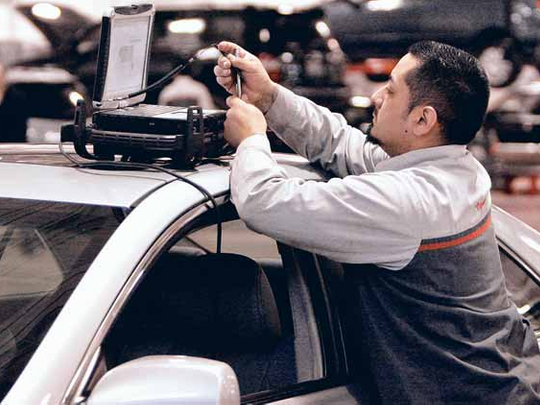
Washington: Federal prosecutors have launched a criminal investigation into Toyota Motor Corp.'s safety problems and the Securities and Exchange Commission was probing what the automaker told investors, the company disclosed on Monday.
Newly released internal documents showed that Toyota officials visited with US regulators years ago who "laughed and rolled their eyes in disbelief" over safety claims.
The twin developments created new public relations challenges for Toyota plus the prospects of hefty federal fines or even indictments against executives in the US and Japan.
They also complicate Toyota's ability to discuss details driving its recall of 8.5 million vehicles because anything executives say could be used against the company inside a courtroom.
Top Toyota executives were expected to testify at hearings Tuesday and Wednesday on Capitol Hill.
A lawmaker said he believed Toyota misled owners about the repairs and relied upon a hastily-arranged study to reassure the public.
In a new filing with the SEC, Toyota said it received the grand jury request from the Southern District of New York on Feb. 8 and got the SEC requests Friday.
It wasn't immediately clear what US laws Toyota might have broken. A subpoena would specify why prosecutors sought company documents, but Toyota would not comment beyond its disclosure with the SEC.
A spokeswoman with the US Attorney's Office for the Southern District of New York declined to comment, saying it does not confirm or deny its investigations as a matter of policy.
The government could be looking into product safety law violations or whether Toyota made false statements to a federal safety agency involving unintended acceleration or the Prius braking system, said Peter Henning, a law professor at Wayne State University in Detroit.
The SEC is seeking documents related to unintended acceleration as well as to its disclosure policies and practices, Toyota said.
Legal experts said the fresh subpoenas could affect how Toyota executives respond to the questions from lawmakers.
House investigators said they believe Toyota intentionally resisted the possibility that electronic defects caused unintended acceleration in their vehicles and then misled the public into thinking its recalls would fix all the problems.
Rep. Bart Stupak, of Michigan, who will run Tuesday's hearing, said documents and interviews demonstrate that the company relied on a flawed engineering report to reassure the public that it found the answer to the problem.
In a letter to Toyota, Stupak said a review of consumer complaints shows company personnel identified sticking pedals or floor mats as the cause of only 16 percent of the unintended acceleration reports.
Some 70 per cent of the acceleration incidents in Toyota's customer call database involved vehicles that are not subject to the 2009 and 2010 floor mat and "sticky pedal" recalls.
In a letter to Transportation Secretary Ray LaHood, Stupak's committee raised questions about whether the agency lacked the expertise to review defects in vehicle electronics and said NHTSA was slow to respond to 2,600 complaints of sudden unintended acceleration from 2000 to 2010.
The government conducted only one investigation, beginning in March 2004, into whether electronic throttle controls could lead to sudden acceleration in Toyota vehicles and closed it a few months later.
Since 2004, NHTSA has rejected four petitions from owners asking for investigations into sudden unintended acceleration in Toyotas.
As regulators looked into reports that accelerator pedals were becoming jammed in floor mats on Lexus ES350 sedans, a Toyota safety official told colleagues that NHTSA didn't appear to be concerned.
"I ran into a lot of different investigators and (Office of Defect Investigations) staff and when asked why I was there, when I told them for the (Lexus) ES350 floor mats, they either laughed or rolled their eyes in disbelief," wrote Chris Santucci, a former NHTSA employee who works for Toyota.
Toyota said it was reviewing the Stupak letter and would cooperate with the committee's inquiry.
Transportation Department officials did not immediately comment on the letters from the congressional panel.
A month later, NHTSA issued an "equipment recall" of floor mats involving 55,000 Toyota Camry and Lexus ES350.
In an internal presentation, the company later said the limited recall saved Toyota $100 million or more. The slide was marked "Wins for Toyota Safety Group."
The internal presentation, obtained by The Associated Press, was dated July 6, 2009, less than two months before a high-speed crash near San Diego killed a California highway patrol officer and his family and renewed concerns over sudden acceleration in Toyotas.
In October 2009, Toyota issued its largest-ever US recall, involving about 4 million vehicles, to address pedals getting stuck in floor mats.
The documents could raise concerns in Congress over whether Toyota put profits ahead of customer safety and pushed regulators to narrow recalls' scope.
Toyota has said its "first priority is the safety of our customers" and promised changes, including an outside review of company operations, more focus on responding to customer complaints and improving communication with federal officials.
The House Energy and Commerce Committee is holding its hearing Tuesday with Jim Lentz, president of Toyota Motor Sales USA, and LaHood.
The House Oversight and Government Reform Committee follows on Wednesday with testimony from Toyota president Akio Toyoda, Yoshimi Inaba, president and chief executive of Toyota Motor North America Inc., NHTSA Administrator David Strickland and LaHood, and safety experts and family members of victims. A Senate committee is planning a March 2 hearing.












